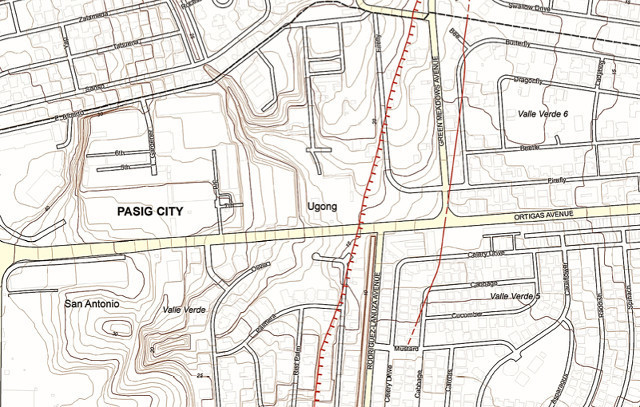FAULT-RIDDEN. Active faults (red lines) cut through a part of Pasig City occupied by subdivisions Valle Verde 5 and 6. Image from Phivolcs' Valley Fault System Atlas
MANILA, Philippines – Maps recently released by the Philippine Institute of Volcanology and Seismology (Phivolcs) allow people to see the location of the West Valley Fault and East Valley Fault in Greater Metro Manila.
The question now is: do you live on an active fault?
Rappler compiled a list of subdivisions or residential villages that appear to have active faults.
At the end of this article, there is also a compilation of screengrabs from the Phivolcs maps showing where the faults are in those subdivisions.
The list only includes places where houses appear to have been built on top of an active fault or where, based on the subdivision's structure, houses are likely to be built on top of the fault.
Affected subdivisions are diverse: from enclaves of the rich like Loyola Grand Villas in Quezon City, to the depressed Maharlika Village in Taguig.
Rappler found that 57 subdivisions or residential villages are transected by the West Valley Fault, a 100-kilometer active fault that can generate a 7.2-magnitude earthquake. (INFOGRAPHIC: How powerful is a magnitude 7.2 earthquake)
Only one subdivision, Gloria Vista Subdivision in Rizal province, is transected by the shorter East Valley Fault which can generate a 6.5-magnitude earthquake.
But we encourage you to take a look at the Valley Fault System Atlas yourself in case we missed something.
According to studies, residential buildings will suffer the most damage during a 7.2-magnitude earthquake because many of them do not follow building standards. Phivolcs Director Renato Solidum Jr said that at least 40% of all residential buildings in Metro Manila would either be heavily or partially damaged.
Subdivisions or villages with the West Valley Fault:
Rizal (Rodriguez)
Amity Ville
Christine Ville
Marikina
Loyola Garden Village
Loyola Subdivision
Monte Vista Village
Industrial Valley Subdivision
Cinco Hermanos Subdivision
Wood Crest Subdivision
Quezon City
Sunnyside Heights Subdivision
Doña Anna Village
Fil-Heights
Filinvest Homes II and Villa Amor Uno
Northview Subd
Loyola Grand Villas
White Plains Subdivision
Queensville Court
Greenmeadows
Blue Ridge B
Pasig
Valle Verde 6
Valle Verde 5
Valle Verde
Valle Verde 3
Valle Verde 1
Kawilihan Village
Makati
East Rembo
Pembo
Rizal
Taguig
Pinagsama
Pinagsama Phase II
Pan-Am Village
North Signal Village
Central Signal Village
South Signal Village
Maharlika Village
Camp Bagong Diwa
Parañaque
Posadas Village
Muntinlupa
Solid Mills Village
Embassy Village
Liberty Homes
Carmina Compounds
L&B Subdivision and Compound
UP Side Subdivision
Country Homes Alabang
Planas Ville
Camella Homes Alabang 3
Country Homes Subd and Jose Marey Subdivision
Camella Homes
Susana Heights Village 1
Susana Heights Subd Phase I
St Anne Homes
Real Ville Subdivision
Laguna
Adelina 1A Subdivision
GSIS Village
Elnor Homes
Sampaguita Village
United San Pedro Subdivision
Cavite
Wedgewoods Subdivision
Next steps
What do you do if your house looks like it's near a fault?
Don't panic.
According to Phivolcs, you'll only need to consider moving out if your home is right on top of the fault or within 5 meters of it.
This is because your house may be at risk when the ground shifts beneath it during an earthquake.
Even if your home is outside the 5-meter bufferzone, it will still be subject to intense shaking during a 7.2-magnitude earthquake. You need to make sure it was built properly. (See groundshaking simulation map on this story: What dangers await when the West Valley Fault moves?)
You can consult a structural engineer to check if the building strictly follows the National Building Code of the Philippines.
Your local government also has building officials responsible for checking if structures in your city or province follow safety standards. But in many cases, these inspectors are handling too much work to look into each building.
If your house is made from concrete hollow blocks, you can do the checking yourself using Phivolcs' checklist for earthquake-ready houses.
Looking to buy a house far from any active fault?
The Housing and Land Use Regulatory Board (HLURB) says they now require subdivision developers to get certification from Phivolcs to prove their project is far from a fault.
To be sure, you can ask the developers to show a copy of the certificate.
What do you do if your subdivision, city or province isn't in the list? Don't be complacent.
A 7.2-magnitude earthquake will be so strong it will likely be felt even in cities without the West Valley Fault.
The Manila Cathedral in Manila, for instance, has been damaged many times by earthquakes generated by the fault.
Have your homes checked for safe building standards, don't take earthquake drills for granted, and always be ready for any scenario.
Source: Excerpts from Rappler.com








0 comments:
Post a Comment